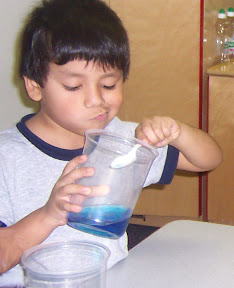Practices of science and engineering
By Peggy Ashbrook
Posted on 2011-12-12
With any profession, including teaching, experience helps the practitioner be better at the job. Not every part of teaching gets easier with years of experience (unbending my knees) but I no longer have to remind myself to use clear phrases to set limits or further children’s thinking, to plan some next steps in the science inquiry, and to make statements about the practice of science. Learning from research as well as our own practice improves our teaching effectiveness. Researchers are finding better ways to describe the process of learning both the concepts and practice of science and they are calling it “practices of science.” This term does not describe a new whole new way of teaching but a new way of describing this complex process.
 The new work from the National Academies Press, A Framework for K-12 Science Education: Practices, Crosscutting Concepts, and Core Ideas, uses the word “practices” to “stress that engaging in scientific inquiry requires coordination both of knowledge and skill simultaneously.” Even young children can learn science content knowledge, such as “water can exist as a gas, a liquid and a solid”, and science skills, such as making observations to find out.
The new work from the National Academies Press, A Framework for K-12 Science Education: Practices, Crosscutting Concepts, and Core Ideas, uses the word “practices” to “stress that engaging in scientific inquiry requires coordination both of knowledge and skill simultaneously.” Even young children can learn science content knowledge, such as “water can exist as a gas, a liquid and a solid”, and science skills, such as making observations to find out.When reading the Framework, it is interesting to reflect on the science activities that the children are currently engaged in. Yes, they are learning about the needs of living organisms by caring for and observing roly-polies, but are they also learning that scientists make observations and record this data to gain understanding of biological systems, and that engineers make observations to be able to design environments (terrariums) to meet the needs of living organisms?
 To apply this new Framework to my work in the classroom I found guidance in Robert Bybee’s article, Scientific and Engineering Practices in K-12 Classrooms, in the December 2011 Science & Children. He describes the relationship between science and engineering as written in the Framework and his explanations helped me understand, and hopefully apply, the science and engineering practices he restates from the Framework.
To apply this new Framework to my work in the classroom I found guidance in Robert Bybee’s article, Scientific and Engineering Practices in K-12 Classrooms, in the December 2011 Science & Children. He describes the relationship between science and engineering as written in the Framework and his explanations helped me understand, and hopefully apply, the science and engineering practices he restates from the Framework.To help bring understanding of engineering practices into your classroom, consider using these resources, and add your own suggestions to this list by commenting below:
- I love to visit other classrooms to see what is working well and think about how to do the same in my work. Join Margaret Berry Wilson, author of What Every Kindergarten Teacher Needs To Know and the Responsive Classroom approach blog, and take a peek into a classroom where the teacher’s “careful selection of age-appropriate tasks…, along with her careful set-up, cheerful reinforcement, and appropriate challenges, made all students feel safe and significant.”
- Engineering Is Elementary (EiE) has several videos of children in grades 2 and up learning about engineering through the EiE storybooks and hands-on explorations. At the end of the videos, the teachers offer tips to implement the lessons.
- Engineering for All: Strategies for helping all students succeed in the design process by Pamela S. Lottero-Perdue, Sarah Lovelidge, and Erin Bowling, describes how “the core practice of engineering, the engineering design process, was taught in a third-grade inclusive classroom in which students used this process to design windmill blades” using the EiE unit, Catching the Wind: Designing Windmills (Science and Children March 2010).
- Family Engineering, developed by the Foundation for Family Science and Engineering, with Michigan Tech and the American Society for Engineering Education, is a program for providing informal engineering learning experiences to elementary age children and their families.
- Engineering, Go For It! (eGFI) sponsored by the American Society for Engineering Education.
What engineering practices do you do in your classroom?
Peggy
Disclaimer: The views expressed in this blog post are those of the author(s) and do not necessarily reflect the official position of the National Science Teaching Association (NSTA).



